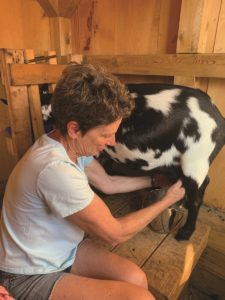I think goat kids are among the cutest creatures on Earth. But most backyard farmers are more interested in goat mamas — does. That’s what happens when you’re keeping goats mainly for their milk.
As with all mammals, goats lactate only after giving birth. After kidding, dairy does will go on to produce milk for about two years if they are milked regularly. Then they will need to be bred again to keep the production flowing.
When we decided to welcome a buck into our pen last winter, I had goat’s milk and goat cheese on my mind. I had not milked our Buttercup after her first kids were born in 2020, but this time I pictured myself getting up at the first light of dawn to hand-squeeze warm goodness into a silver pail.

A doe’s udder and two teats come in all shapes and sizes, but all are relatively small prior to her first breeding. Afterwards, usually, they grow large enough for a farmer to wrap her fingers around. But sometimes it’s more practical to wait until a doe has been pregnant more than once, so the farmer can get a better grip.
The first milky fluid a doe produces after giving birth is called colostrum. Just as in humans, this highly nutritious milk is rich in fat, growth hormones, vitamins, minerals, and antibodies that help the newborn get off to a healthy start. Colostrum has a yellowish tint and does not taste like regular milk. It should always be saved for a doe’s kids, who need it to thrive.
After about a week, the dairy farmer can decide when to start milking her goat. Some allow the kids to be nursed exclusively — or, in farming terms, “dam raised” — until they can be weaned, when they’re 60 to 90 days old. Others bottle-feed the kids so they can start milking early on, when the doe’s milk is most plentiful. That’s a time-consuming proposition, though it fosters a strong bond between human and kid.
Most often, farmers choose a middle path, allowing kids to nurse for a few weeks, then separating the doe from the kids for part of the day so that the milk she produces during that time can be collected. Every mammal’s milk production works by the law of supply and demand. If a doe is milked frequently, she will produce more milk. If a farmer waits 60 days before milking a doe, her kids begin nursing less frequently and eating hay and grain sooner, as the doe’s milk production slows.
On large dairy farms, does are milked using machines outfitted with suction cups. Backyard farmers rarely invest in such contraptions and prefer the bare-hands-and-bucket method.
The first challenge, I learned, is keeping the doe still enough to get to her teats. This is where a milking stand comes in handy. They are designed to gently hold the goat’s neck so that her head is strategically placed in front of a full feeding bowl. The height of the stand allows the farmer to sit comfortably on a stool while reaching under the doe.
The motion of milking is gentle. It starts at the top, where the teat meets the udder. From there, the farmer uses her thumb and index finger to massage the length of the teat with small rhythmic squeezes until the milk begins to squirt. Alternately squeezing one teat, then the other, leads to the best flow.
In spite of my romantic notions about collecting little silver buckets of milk, Buttercup and I did not find the arrangement easy. I read that a doe must learn to relax before milking or production will be low. I learned that massaging her back, belly, and legs and speaking to her softly is supposed to help. But Buttercup kicked and squirmed while this year’s swarm of mosquitos attacked my arms and legs. Even with my patient husband holding her head for me and whispering in her ears to calm her, we lasted only three weeks.
Fellow backyard farmer Cammie Watson of Truro and her doe, Missy, fared much better. Watson milks Missy every evening, allowing her three-month-old kid, Butternut, to nurse during the night. “I get about two cups of milk, and Butternut gets the same amount,” Watson says.
At least I know what I imagined really is possible.
“I love milking,” Cammie says. “It feels calming and healing to me. I love the quiet sound of Missy chewing and the sound of the milk streaming into the pail.”



